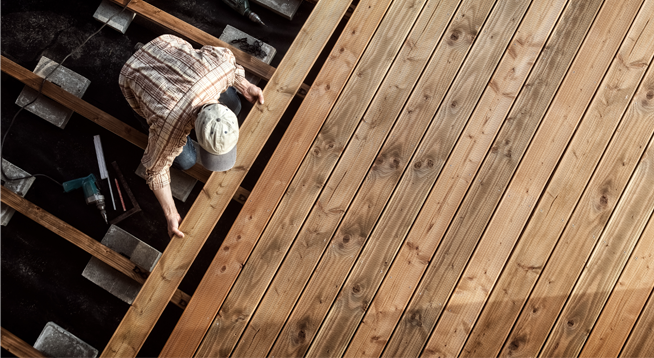The Inside Outside Guys: Common Questions About Deck Maintenance
By Ken Calverley and Chuck Breidenstein
DETROIT, April 7, 2022 ~ The Guys get a lot of questions this time of year regarding decks. Most either involve refinishing a wood deck, maintenance issues for older decks or decks people want to add a three-season room to.
Here are some of the more common inquiries.
Q. I have a 6-year-old pressure treated wood deck that is gray and unfinished. Is there something I can do to help restore its original color and protect the wood?
A. For pressure treated lumber, an easy way to restore original looks and help preserve the material is to treat it with a boiled linseed oil product in the late fall or early spring. After power washing the deck and allowing it to dry, apply the oil with the grain using microfiber clothes or a medium bristle brush and work the oil in to the wood. A second coat applied after the first has dried will provide a good seal for the wood and an attractive finish.
Do not allow the oil to puddle. The second coat should cure for at least 24 hours prior to use.
Q. I have a wood deck that we would like to stain. What is the best product to use?
A. The Guys suggest using a semi-transparent, oil-based stain. There are several benefits to using this type of product. It will help preserve the wood and keep water out of it and it will not bubble or peel as many paints and overcoat stains are prone to do on decks.
This product can also be reapplied as the color fades with a minimum of preparation.
— Look for proper fastener placement that does not undermine wood edges or trust a single fastener to do the work of three.
—The joint where house meets deck. Look for any signs of rot or separation of joints. Direct connections that are not professionally anchored, flashed and counter flashed can create wood rot and contribute to collapse.
— You should be able to find grade stamps on the deck lumber. Proper wood specification includes #2 or better minimum grade and a .40 or better saturation of treatment in Southern Yellow Pine or better. For ground contact posts, we prefer a .60 saturation of treatment and heartwood at #2 or better. Ground around posts should be well drained.
— Use an awl (think ice pick) to probe wood for punkiness and rot.
— Do not direct ground, roof or lawn water (think sprinkler heads), toward a deck.
— Stair stringers should be professionally specified, assembled and attached to the frame.
— Handrails should be continuous, readily graspable throughout the stairway and strong enough to support the intended loads. A 2 by 6 is not a graspable handrail for many people.
— Intermediate vertical supports in railings should be secure and spaced such that a 4- inch diameter sphere cannot pass between them at any point including the space between the bottom of the rail assembly and the deck.
— Rail posts should be bolted to the floor frame and the framing supports should transfer the load of each post to more than one joist. This prevents any “wobble.” Deck rails are very often under-built and poorly fastened.
— Supports between beams, joists and deck planks should be close enough together such that there is no deflection, (bending/dipping), in the beams, joists or deck planks. Properly done, this should eliminate “bounce” in the deck.
— Diagonal supports intended to prevent racking should be properly specified and attached.
Q. Can I have a three-season room built on top of my existing wood deck?
A. Generally, the answer is “no.” A three-season room will add the static loads of walls and a roof to a deck designed for people. Even adding a child’s sandbox or a hot tub to a deck can create an overload situation that could lead to eventual collapse.
Professional sunroom companies will inspect the existing deck and may suggest some re-engineering or a complete rebuild to accommodate an enclosure.
Additionally, many houses have decks undertaken as DYI projects that, perhaps, should have been relegated to a professional.

